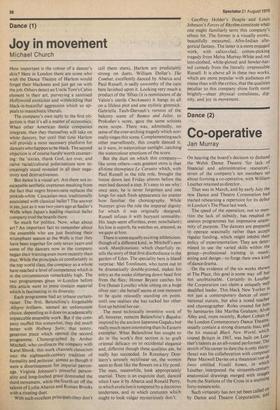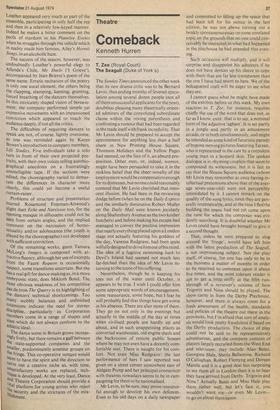Dance (2)
Co-operative
Jan Murray
On hearing the board's decision to disband the Welsh Dance Theatre for lack of financial and administrative resources'. seven of the company's ten members set about forming a co-operative, with William Louther retained as director.
That was in March, and by early July the new Dance and Theatre Corporation had started rehearsing a repertoire for its debut in London's The Place last week.
The speed of the operation, not to mention the lack of subsidy, has resulted in uneven programmes but impressive unani mity of purpose. The dancers are prepared to operate seasonally rather than accept regular funding, which might inhibit their policy of experimentation. They are determined to use the varied skills within the group—professional training in music, acting and design—to forge their own kind of dance drama.
On the evidence of the six works shown at The Place, this goal is some way off but not unobtainable. Certainly in Louther the Corporation can claim a uniquely well qualified leader. This black New Yorker is
not just a contemporary dancer of inter
national stature, but also a noted teacher and choreographer. Roles created for hurl by luminaries like Martha Graham, Alvin Ailey and, more recently, Robert Cohan of the London Contemporary Dance Theatre.
usually contain a strong dramatic bias, and the hit musical Black Nett, World, which toured Britain in 1967, was built on LOn
ther's talents as an all-round performer. The
zenith of his career to date (he is only thirtYthree) was his collaboration with composer
Peter Maxwell Davies on a theatrical tour de
force entitled Vesalii Icones, in which Louther interpreted the sixteenth-centurY anatomical drawings merged with imag. es from the Stations of the Cross in a stunning forty-minute solo. Such virtuosity has not yet been called on by Dance and Theatre Corporation, an
Louther appeared very much as part of the ensemble, participating in only half the rep and then in a relatively low-keyed manner. Indeed he makes a bitter comment on the perils of stardom in his Plaintive Events when he struggles through the vehicle which in reality made him famous, Ailey's Hermit Songs, in an alcoholic haze.
The success of the season, however, was undoubtedly Louther's powerful elegy to Allende's Chile, Me Duele ('I Grieve'), accompanied by Jean Brierre's poem of the same name. Erratic recitation of the, poetry IS only one aural element, the others being the clapping, stamping, keening, grunting, forced breathing of the dancers themselves. In this intricately shaped vision of bereavement, the company performed simple yet expressive movements with an impassioned Conviction which appeared to touch the audience deeply, if not all the critics.
The difficulties of requiring dancers to sPeak are not, of course, lightly overcome, as one was reminded again by Karen Bowen's introduction to company members, Life Studies. Five individuals take a solo turn in front of their own projected portraits, with their own voices telling autobiographical anecdotes on a frustratingly unintelligible tape. If the sections were edited, the choreography varied to demarcate the differences in, character more Clearly, this could yet become a useful curtain-raiser.
Problems of structure and presentation Marred Rosamond Freeman-Attwood's Slight duet Echo and Narcissus too, for the opening masque in silhouette could not be seen from certain angles, and the implied comment on the narcissism of homosexuality and/or adolescence (the youth is Played by the choreographer) not developed With sufficient conviction.
Of the remaining works, guest Tamara McLorg's Images is composed with attractive fluency, although her use of excerpts from the Faure Reorient is occasionally 8,usPect, some transitions uncertain. But she nas a real gift for dance-making as, in a more embryonic state, does Mikloth Bond. The Most obvious weakness of his competitive Das de trois The Quarry is its highlighting of the dancers' technical shortcomings. Too many wobbly balances and unfinished extensions indicate the need for sterner discipline, particularly as Corporation rneMbers come in a range of shapes and sizes which do not always conform to the athletic ideal.
The dance scene in Britain grows increasInglY lively, but there remains a gulf between the state-supported companies and the smaller, predominantly amateur groups on the fringe. This co-operative ventpre would Seeiwto have the spirit and the direction to carve out a creative niche as, with time, unsatisfactory works are replaced, techTclUe is developed. At the very least, Dance cl Theatre Corporation should provide a ti.ltal platform for young artists who reject k",F security and the strictures of the estaullshment.



































 Previous page
Previous page